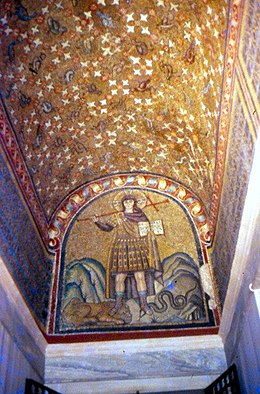This article includes a list of general references, but it lacks sufficient corresponding inline citations .(September 2018) |
| UNESCO World Heritage Site | |
|---|---|
 A 6th-century mosaic in the Archiepiscopal Chapel | |
| Official name | Archiepiscopal Chapel |
| Location | Ravenna, Italy |
| Part of | Early Christian Monuments of Ravenna |
| Criteria | Cultural: (i), (ii), (iii), (iv) |
| Reference | 788-004 |
| Inscription | 1996 (20th Session) |
| Area | 0.002 ha (220 sq ft) |
| Buffer zone | 3.02 ha (325,000 sq ft) |
| Coordinates | 44°24′55.8″N12°11′51.9″E / 44.415500°N 12.197750°E |
The Archbishop's Chapel (or Archiepiscopal Chapel) is a chapel on the first floor of the bishops' palace in Ravenna, Italy, the smallest of the famous mosaic sites of the city. It is a private oratory of Trinitarian bishops dating from the turn of the 6th century. Although commonly attributed to St. Peter Chrysologus, Archbishop of Ravenna from 433–450, the chapel was actually built by Peter II shortly after he became archbishop in 495. The mosaics date from the original construction, or soon after.
